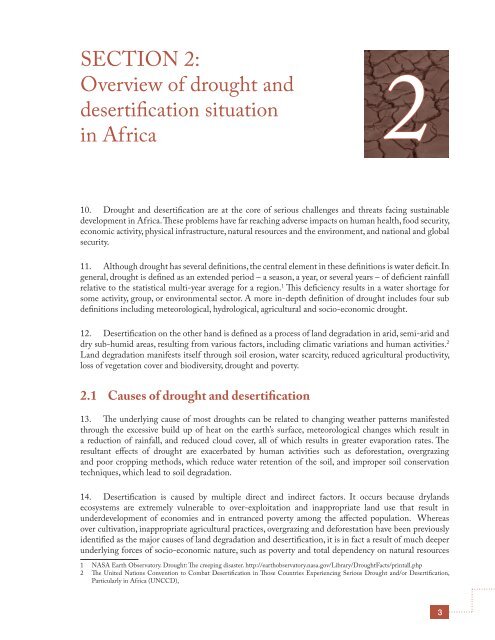drought desertification - United Nations Economic Commission for ...
drought desertification - United Nations Economic Commission for ...
drought desertification - United Nations Economic Commission for ...
You also want an ePaper? Increase the reach of your titles
YUMPU automatically turns print PDFs into web optimized ePapers that Google loves.
SECTION 2:<br />
Overview of <strong>drought</strong> and<br />
<strong>desertification</strong> situation<br />
in Africa<br />
2<br />
10. Drought and <strong>desertification</strong> are at the core of serious challenges and threats facing sustainable<br />
development in Africa. These problems have far reaching adverse impacts on human health, food security,<br />
economic activity, physical infrastructure, natural resources and the environment, and national and global<br />
security.<br />
11. Although <strong>drought</strong> has several definitions, the central element in these definitions is water deficit. In<br />
general, <strong>drought</strong> is defined as an extended period – a season, a year, or several years – of deficient rainfall<br />
relative to the statistical multi-year average <strong>for</strong> a region. 1 This deficiency results in a water shortage <strong>for</strong><br />
some activity, group, or environmental sector. A more in-depth definition of <strong>drought</strong> includes four sub<br />
definitions including meteorological, hydrological, agricultural and socio-economic <strong>drought</strong>.<br />
12. Desertification on the other hand is defined as a process of land degradation in arid, semi-arid and<br />
dry sub-humid areas, resulting from various factors, including climatic variations and human activities. 2<br />
Land degradation manifests itself through soil erosion, water scarcity, reduced agricultural productivity,<br />
loss of vegetation cover and biodiversity, <strong>drought</strong> and poverty.<br />
2.1 Causes of <strong>drought</strong> and <strong>desertification</strong><br />
13. The underlying cause of most <strong>drought</strong>s can be related to changing weather patterns manifested<br />
through the excessive build up of heat on the earth’s surface, meteorological changes which result in<br />
a reduction of rainfall, and reduced cloud cover, all of which results in greater evaporation rates. The<br />
resultant effects of <strong>drought</strong> are exacerbated by human activities such as de<strong>for</strong>estation, overgrazing<br />
and poor cropping methods, which reduce water retention of the soil, and improper soil conservation<br />
techniques, which lead to soil degradation.<br />
14. Desertification is caused by multiple direct and indirect factors. It occurs because drylands<br />
ecosystems are extremely vulnerable to over-exploitation and inappropriate land use that result in<br />
underdevelopment of economies and in entranced poverty among the affected population. Whereas<br />
over cultivation, inappropriate agricultural practices, overgrazing and de<strong>for</strong>estation have been previously<br />
identified as the major causes of land degradation and <strong>desertification</strong>, it is in fact a result of much deeper<br />
underlying <strong>for</strong>ces of socio-economic nature, such as poverty and total dependency on natural resources<br />
1 NASA Earth Observatory. Drought: The creeping disaster. http://earthobservatory.nasa.gov/Library/DroughtFacts/printall.php<br />
2 The <strong>United</strong> <strong>Nations</strong> Convention to Combat Desertification in Those Countries Experiencing Serious Drought and/or Desertification,<br />
Particularly in Africa (UNCCD),<br />
3

















